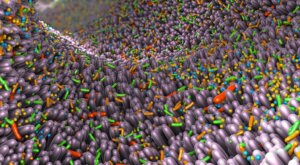What Are Postbiotics?

In recent years, the term “postbiotic” has become popular in places that promote well-being and health. Scientists also refer to them as metabiotics, biogenics, or metabolites. Be that as it may, postbiotics are bioactive compounds or inanimate microorganisms that give you health benefits.
You’re probably already familiar with the terms probiotic (live microorganisms crucial for digestion and homeostasis) and prebiotic (food for probiotics that promote their development). Postbiotics are nothing more than the compounds that form when said microorganisms feed on certain compounds. The process is complex, but we’ll summarize it below.
Characteristics of postbiotics

In 2021, the International Scientific Association for Probiotics and Prebiotics (ISAPP) defined postbiotics as ‘a preparation of inanimate microorganisms or their components that confer a health benefit on the host’. In this sense, they’re composed of non-living microbial biomass, be it complete microbial cells or cellular components.
It has been known for decades that inactivated microorganisms affect the body’s health. However, it wasn’t until the investigations of recent years that the scope of these was understood. It’s for this reason that the term postbiotic has recently become popular. Along with probiotics and prebiotics, they are now considered part of a person’s microbiome.
Billions of microorganisms live in your body. These form an almost perfect balance, and each person has a completely different microbiome. A mismatch in this microbiome (dysbiosis) can lead to allergic processes, autoimmune diseases, and some psychiatric disorders (among other things).
The interdependent relationship between the organism and its microbiome is consolidated at around 3 years of age. The method of delivery, the mother’s microbiome, stress, the type of food the mother consumes and the diet all affect each person’s type of microbiome. As experts point out, there are currently three ways to alter this microbiome: through prebiotics, probiotics, and postbiotics.
Health benefits of postbiotics

The benefits of postbiotics can be both direct and indirect. Bacteria and fungi are the ones that mainly generate these benefits, while viruses are left out of this classification. This is because viruses, including bacteriophages, aren’t considered by the medical community to be living microorganisms. This is because they don’t conform to the above international definition.
Before listing its benefits, it’s good to know that postbiotics are different from synbiotics. Symbiotics are the union of prebiotics and probiotics, and, even though they also provide benefits to the body, it’s a different category. So far, only positive effects have been found, and it’s believed that these are identical to those of probiotics (with the exception that their intake is safer).
Indeed, in some people, the intake of probiotics leads to certain side effects such as bloating, gas, diarrhea, stomach aches and even mental confusion.
Artificial processes in laboratories (heat, high pressure, oxygen exposure, and so on) can produce postbiotics. Because of this, they have begun to be sold and included in some foods. Here are its benefits according to the experts:
- Immunomodulatory effects
- Antitumor effects
- Infection prevention
- Antiatherosclerotic effects
- Autophagy (cleaning out organelles and damaged proteins)
- Accelerated wound healing
This is why experts consider them to be an essential component of early childhood and adulthood. We reiterate that the body produces postbiotics naturally, always taking into account the factors we have already mentioned (stress, diet, and others). As with prebiotics or probiotics, they can be obtained through supplements and functional food.
Despite this, and before considering the intake of supplements, the ideal thing is to use natural methods to encourage its production. That is, a diet rich in fiber, legumes, fruits, cereals and vegetables, regular exercise, and reduced stress levels. However, always consult a specialist before including a supplement intake in your diet.
Final thoughts
Although it’s true that postbiotics have been studied for decades, the truth is that there’s still much to learn about them. In some media, they’re described as pretty much the fountain of youth or the elixir of life, but this is not at all the case.
Furthermore, we know that a healthy person’s microbiome produces enough of these to provide the benefits attributed to them.
Postbiotics play a crucial role in health, but, as with other compounds like vitamins, you can obtain them without resorting to supplements. Research regarding them is still being carried out, and it’s likely that during the next few years, we’ll understand much more about their interaction in our bodies.
In recent years, the term “postbiotic” has become popular in places that promote well-being and health. Scientists also refer to them as metabiotics, biogenics, or metabolites. Be that as it may, postbiotics are bioactive compounds or inanimate microorganisms that give you health benefits.
You’re probably already familiar with the terms probiotic (live microorganisms crucial for digestion and homeostasis) and prebiotic (food for probiotics that promote their development). Postbiotics are nothing more than the compounds that form when said microorganisms feed on certain compounds. The process is complex, but we’ll summarize it below.
Characteristics of postbiotics

In 2021, the International Scientific Association for Probiotics and Prebiotics (ISAPP) defined postbiotics as ‘a preparation of inanimate microorganisms or their components that confer a health benefit on the host’. In this sense, they’re composed of non-living microbial biomass, be it complete microbial cells or cellular components.
It has been known for decades that inactivated microorganisms affect the body’s health. However, it wasn’t until the investigations of recent years that the scope of these was understood. It’s for this reason that the term postbiotic has recently become popular. Along with probiotics and prebiotics, they are now considered part of a person’s microbiome.
Billions of microorganisms live in your body. These form an almost perfect balance, and each person has a completely different microbiome. A mismatch in this microbiome (dysbiosis) can lead to allergic processes, autoimmune diseases, and some psychiatric disorders (among other things).
The interdependent relationship between the organism and its microbiome is consolidated at around 3 years of age. The method of delivery, the mother’s microbiome, stress, the type of food the mother consumes and the diet all affect each person’s type of microbiome. As experts point out, there are currently three ways to alter this microbiome: through prebiotics, probiotics, and postbiotics.
Health benefits of postbiotics

The benefits of postbiotics can be both direct and indirect. Bacteria and fungi are the ones that mainly generate these benefits, while viruses are left out of this classification. This is because viruses, including bacteriophages, aren’t considered by the medical community to be living microorganisms. This is because they don’t conform to the above international definition.
Before listing its benefits, it’s good to know that postbiotics are different from synbiotics. Symbiotics are the union of prebiotics and probiotics, and, even though they also provide benefits to the body, it’s a different category. So far, only positive effects have been found, and it’s believed that these are identical to those of probiotics (with the exception that their intake is safer).
Indeed, in some people, the intake of probiotics leads to certain side effects such as bloating, gas, diarrhea, stomach aches and even mental confusion.
Artificial processes in laboratories (heat, high pressure, oxygen exposure, and so on) can produce postbiotics. Because of this, they have begun to be sold and included in some foods. Here are its benefits according to the experts:
- Immunomodulatory effects
- Antitumor effects
- Infection prevention
- Antiatherosclerotic effects
- Autophagy (cleaning out organelles and damaged proteins)
- Accelerated wound healing
This is why experts consider them to be an essential component of early childhood and adulthood. We reiterate that the body produces postbiotics naturally, always taking into account the factors we have already mentioned (stress, diet, and others). As with prebiotics or probiotics, they can be obtained through supplements and functional food.
Despite this, and before considering the intake of supplements, the ideal thing is to use natural methods to encourage its production. That is, a diet rich in fiber, legumes, fruits, cereals and vegetables, regular exercise, and reduced stress levels. However, always consult a specialist before including a supplement intake in your diet.
Final thoughts
Although it’s true that postbiotics have been studied for decades, the truth is that there’s still much to learn about them. In some media, they’re described as pretty much the fountain of youth or the elixir of life, but this is not at all the case.
Furthermore, we know that a healthy person’s microbiome produces enough of these to provide the benefits attributed to them.
Postbiotics play a crucial role in health, but, as with other compounds like vitamins, you can obtain them without resorting to supplements. Research regarding them is still being carried out, and it’s likely that during the next few years, we’ll understand much more about their interaction in our bodies.
- Homayouni Rad A, Aghebati Maleki L, Samadi Kafil H, Fathi Zavoshti H, Abbasi A. Postbiotics as novel health-promoting ingredients in functional foods. Health Promot Perspect. 2020;10(1):3-4. Published 2020 Jan 28.
- Salminen, S., Collado, M. C., Endo, A., Hill, C., Lebeer, S., Quigley, E. M., … & Vinderola, G. The International Scientific Association of Probiotics and Prebiotics (ISAPP) consensus statement on the definition and scope of postbiotics. Nature Reviews Gastroenterology & Hepatology. 2021; 18(9): 649-667.
- Vinderola G, Sanders ME, Salminen S. The Concept of Postbiotics. Foods. 2022 Apr 8;11(8):1077.
- Wegh CAM, Geerlings SY, Knol J, Roeselers G, Belzer C. Postbiotics and Their Potential Applications in Early Life Nutrition and Beyond. Int J Mol Sci. 2019;20(19):4673. Published 2019 Sep 20.
- Żółkiewicz J, Marzec A, Ruszczyński M, Feleszko W. Postbiotics-A Step Beyond Pre- and Probiotics. Nutrients. 2020;12(8):2189. Published 2020 Jul 23.
Este texto se ofrece únicamente con propósitos informativos y no reemplaza la consulta con un profesional. Ante dudas, consulta a tu especialista.







